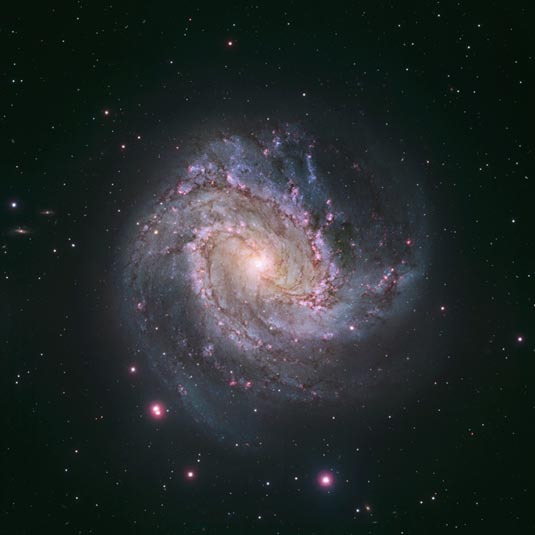
in the Southern Pinwheel
Barred Spiral Galaxy
R.A. 13h 37m 0s.95 Dec. -29° 51' 55".51
Hydra
15 million light-years (4.5 million parsecs)
WFC3/UVIS
August 2009 - September 2012
20 hours
NASA, ESA, and the Hubble Heritage Team (STScI/AURA)
January 9, 2014
More M83: G0525 G0825 G0917 G0929 G1020 G1404 G1404(closeup)
ABOUT THIS IMAGE:
A photogenic and favorite target for amateur astronomers, the full beauty of nearby spiral galaxy M83 is unveiled in all of its glory in this Hubble Space Telescope mosaic image. The vibrant magentas and blues reveal the galaxy is ablaze with star formation. The galaxy, also known as the Southern Pinwheel, lies 15 million light-years away in the constellation Hydra.
The Hubble photograph captures thousands of star clusters, hundreds of thousands of individual stars, and "ghosts" of dead stars called supernova remnants. The galactic panorama unveils a tapestry of the drama of stellar birth and death spread across 50,000 light-years.
The newest generations of stars are forming largely in clusters on the edges of the dark spiral dust lanes. These brilliant young stellar groupings, only a few million years old, produce huge amounts of ultraviolet light that is absorbed by surrounding diffuse gas clouds, causing them to glow in pinkish hydrogen light.
Gradually, the fierce stellar winds from the youngest, most massive stars blow away the gas, revealing bright blue star clusters and giving a "Swiss Cheese" appearance to the spiral arms. These youngest star clusters are about 1 million to 10 million years old. The populations of stars up to 100 million years or older appear yellow or orange by comparison because the young blue stars have already burned out.
Interstellar
"bubbles" produced by nearly 300 supernovas from massive stars
have been found in this Hubble image. By studying these supernova remnants,
astronomers can better understand the nature of the stars that exploded
and dispersed nuclear processed chemical elements back into the galaxy,
contributing to the next generation of new stars.
Colors:
This image is a composite of separate exposures acquired by the WFC3 instrument
on the Hubble Space Telescope. Several filters were used to sample broad
and narrow wavelength ranges. The color results from assigning different
hues (colors) to each monochromatic (grayscale) image associated with
an individual filter. In this case, the assigned colors are:
F336W (U) purple
F438W (B) blue
F555W (V) + F547M (Strömgren y) green
F657N (H-alpha) orange
F814W (I) red